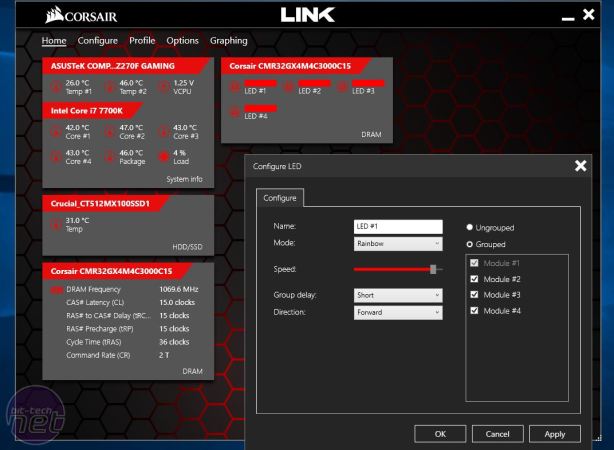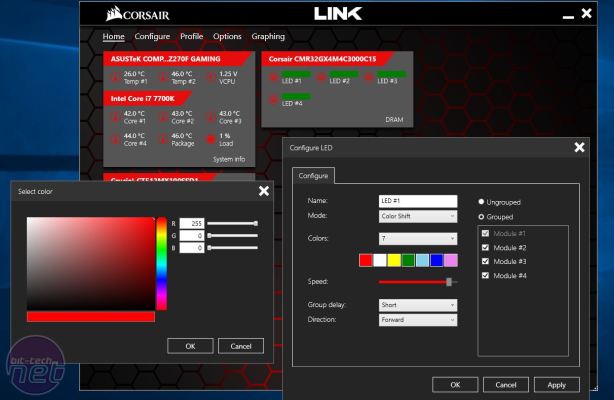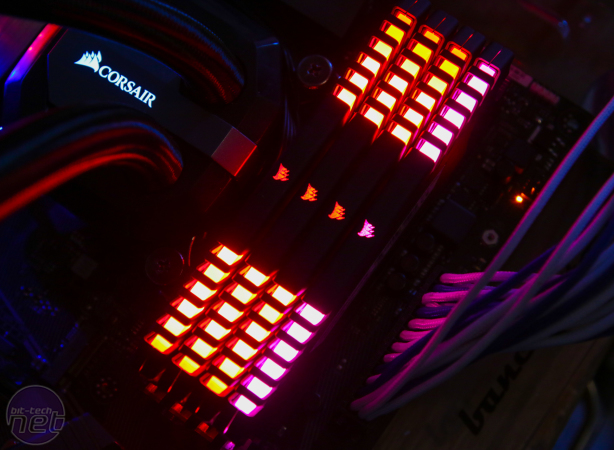
However, the most important feature of the Vengeance RGB is that unlike GeiL's kit, there's no need for any extra cables, even to control the lighting. Its LINK software communicates with the MCU on the DIMMs over the SM bus, so you can fiddle around with the lighting using the LINK software as easily as you would one of its AIO coolers.
The software has four control modes for the DIMMs. Static mode is fairly self-explanitory. Colour pulse gently brightens then dims the LEDS in a specific colour or can move between up to seven difference fully-customisable colours. By adding a group delay, the effect can spread along the DIMMs which looks quite funky.
Colour shift cuts out the dimming from the pulse mode and simply moves between colours, again with the option of adding a delay so can you can have a wave effect across the DIMMS. Finally, there's a rainbow mode that works a lot like colour shift, except with a more rapid effect that spans the whole RGB spectrum and not just up to seven colours.
Colour accuracy is good, although if you darken off colours things do start to stray from the colour you see on the screen, but it's a minor issue. There's no brightness control either, although you can achieve something similar by just dragging the RGB pointer to a darker or more vibrant shade in static, pulse or shift modes. We should point out that our DSLR doesn't pick up reds very well, which appear orange here - the actual colour as viewed with a mk1 eyeball is much more accurate. A quick trip to the EFI and our kit was also happy to run at 3200MHz if we upped the timings from 15-17-17-35 to 16-17-17-36, but at the stock settings with the XMP profile the system wouldn't boot if we upped the speed to 3200MHz.
Conclusion
Given the extra control and features you have over the standard Vengeance LED kits, the Vengeance RGB is absolutely worth the extra cash. As we mentioned at the start, the 16GB 3000MHz dual-channel kit is only £15 more, but has some fantastic lighting effects plus the ability to colour-match to whatever colour scheme takes your fancy in future. It's also great that Corsair has found a way to avoid using any extra cables, although for now, there seems to be no way of syncing its modules with other RGB controllers such as Asus Aura. Even so, this is some fantastic memory if you're keen on RGB illumination that thankfully doesn't cost a whole lot more than the standard LED version.
The software has four control modes for the DIMMs. Static mode is fairly self-explanitory. Colour pulse gently brightens then dims the LEDS in a specific colour or can move between up to seven difference fully-customisable colours. By adding a group delay, the effect can spread along the DIMMs which looks quite funky.
Colour shift cuts out the dimming from the pulse mode and simply moves between colours, again with the option of adding a delay so can you can have a wave effect across the DIMMS. Finally, there's a rainbow mode that works a lot like colour shift, except with a more rapid effect that spans the whole RGB spectrum and not just up to seven colours.
Colour accuracy is good, although if you darken off colours things do start to stray from the colour you see on the screen, but it's a minor issue. There's no brightness control either, although you can achieve something similar by just dragging the RGB pointer to a darker or more vibrant shade in static, pulse or shift modes. We should point out that our DSLR doesn't pick up reds very well, which appear orange here - the actual colour as viewed with a mk1 eyeball is much more accurate. A quick trip to the EFI and our kit was also happy to run at 3200MHz if we upped the timings from 15-17-17-35 to 16-17-17-36, but at the stock settings with the XMP profile the system wouldn't boot if we upped the speed to 3200MHz.
Conclusion
Given the extra control and features you have over the standard Vengeance LED kits, the Vengeance RGB is absolutely worth the extra cash. As we mentioned at the start, the 16GB 3000MHz dual-channel kit is only £15 more, but has some fantastic lighting effects plus the ability to colour-match to whatever colour scheme takes your fancy in future. It's also great that Corsair has found a way to avoid using any extra cables, although for now, there seems to be no way of syncing its modules with other RGB controllers such as Asus Aura. Even so, this is some fantastic memory if you're keen on RGB illumination that thankfully doesn't cost a whole lot more than the standard LED version.


MSI MPG Velox 100R Chassis Review
October 14 2021 | 15:04












Want to comment? Please log in.